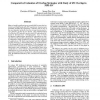Free Online Productivity Tools
i2Speak
i2Symbol
i2OCR
iTex2Img
iWeb2Print
iWeb2Shot
i2Type
iPdf2Split
iPdf2Merge
i2Bopomofo
i2Arabic
i2Style
i2Image
i2PDF
iLatex2Rtf
Sci2ools
SIGOPS
2008
2008
Comparative evaluation of overlap strategies with study of I/O overlap in MPI-IO
Many scientific applications use parallel I/O to meet the low latency and high bandwidth I/O requirement. Among many available parallel I/O operations, collective I/O is one of the most popular methods when the storage layouts and access patterns of data do not match. The implementation of collective I/O typically involves disk I/O operations followed by interprocessor communications. Also, in many I/O-intensive applications, parallel I/O operations are usually followed by parallel computations. This paper presents a comparative study of different overlap strategies in parallel applications. We have experimented with four different overlap strategies 1) Overlapping I/O and communication; 2) Overlapping I/O and computation; 3) Overlapping computation and communication; and 4) Overlapping I/O, communication, and computation. All experiments have been conducted on a Linux Cluster and the performance results obtained are very encouraging. On an average, we have enhanced the performance of...
| Added | 15 Dec 2010 |
| Updated | 15 Dec 2010 |
| Type | Journal |
| Year | 2008 |
| Where | SIGOPS |
| Authors | Christina M. Patrick, Seung Woo Son, Mahmut T. Kandemir |
Comments (0)

